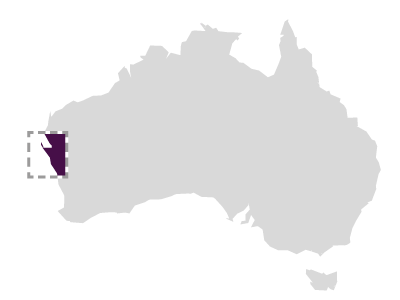Correio da Azia (1816/11/25)
Point Cloates

1817 Emilla was dispatched to salvage the Correio da Azia. Capt. Pedro Jose da Silva Loureiro, Pilot Luis Beltrao
The Correio da Azia was ‘coming from Lisbon to Macau against weather, seas and wind, fire, shallows and coastal dangers and errors of maps’ (de Freitas 1816) when it ran aground on Ningaloo reef on 26 November, 1816. Established by the Portuguese in 1557 and returned to China in 1999, Macau was the oldest permanent European settlement in Asia. In the sixteenth and seventeenth centuries, it was the pioneer mercantile settlement on the trade route from Europe to the Far East. Although the Correio da Azia was following an established route of the Portuguese China trade, the contemporary charts clearly underestimated the size of the Western extension of Point Cloates. This, combined with a number of mishaps including a fire in the binnacle which prohibited navigation by compass, may have contributed to the loss.
The survivors from the wreck set off in the ship’s boat stopping once further up the West Australian coast to make repairs to the vessel. The Captain’s account makes mention of the fact that no natives were seen, despite crew apprehension and that two of the crew were accidentally left behind. It was concluded that animals or natives had killed these sailors when they could not be found. Shortly thereafter, the ship’s boat was picked up by an American ship from Philadelphia, named the Caledonia and the survivors eventually reached Macau. A party was sent back in the brigantine Emillia in the hope of salvaging the wreck of the Correio da Azia, but no trace of the ship could be found.
There have been a number of documentary sources related to the Correio da Azia found in archives. The account of the loss by Joao Joaquim de Freitas, Captain of Correio da Azia was found by Steve Lubkemann of Brown University, at the Arquivo Historico Ultramarino in Lisbon, being part of a report filed by Manuel de Arriaga Silveira, Governor of Macau. This document dated February 1817, also describes the organization of the Emillia salvage expedition prior to the mission itself.
The second account was written by Luis Antonio da Silva Beltrao, a pilot of the Emillia, hired to chart the navigational dangers for the proposed salvage of the Correio da Azia. The report was published in Calcutta in 1818. At the Museum’s instigation, a copy of this document was located and purchased by the Western Australian Library Board in 1987. The account deals largely with issues relating to the longitude and plotting of Point Cloates, which was at the time a notorious navigational danger. This was especially important, for all charts of the region were actually based on those de Vlamingh produced in the late 17th century, While more recent charts were available, namely those of Flinders and de Freycinet; neither of these explorers had charted this part of the Australian coast, as the Portuguese and many others had thought (Scott 1914:195).
Therefore the information available in 1816 was a composite work derived from earlier charts, inherent with the navigational errors of that period. The Beltrao instructions mentions, but does not locate, the exact position of the site. The account also mentions how the Captain of the rescue ship Caledonia showed his charts of the coast to de Freitas who noted the longitude was 2º 25’ by the ‘London Meridian’ (Erskine 1998 after Beltrao 1818). This is a reference to the difference in longitude between Greenwich and Paris. While Greenwich was the Prime meridian by the end of the 18th century, some French cartographers insisted on defining longitude as east or west of Paris. The implication is that the Captain of the Correio da Azia was using a French chart of the Western Australian Coast (Erskine 1998:57).
The wrecking of a Portuguese vessel at Point Cloates in 1816 is also mentioned in the 1841 edition of The India Directory or Directions for Sailing to and from the East Indies, China and Australia and the adjacent ports of Africa and South America by James Horsburgh.
Found by Fugro Survey in concert with J Green in 2004, the wreck was surveyed and identified, with partial excavation and further remote sensing analyses
by the Museum led by Green.
Ship Built
Owner Joao Nunes da Silveira
Master Joao Joaquim de Freitas
Country Built Portugal
Port Registered Lisbon (?)
Ship Lost
Grouped Region Mid-West
When Lost 1816/11/25
Where Lost Point Cloates
Latitude -22.863433
Longitude 113.750667
Position Information +GPS2004
Port From Lisbon
Port To Macau
Ship Details
Museum Reference
Unique Number 68
Sunk Code Wrecked and sunk
File Number 2009/0096/SG _MA-68/88
Chart Number 1056
Protected Protected Federal
Found Y
Inspected Y
Date Inspected 2004/04/28
Confidential NO